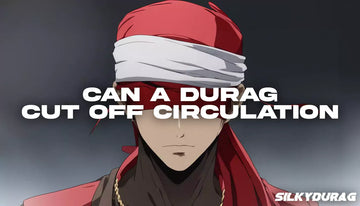If you're a durags fan, you may wonder if wearing one can cause hair loss. The truth is, there is no straightforward answer to this question. Hair loss can result from various factors, including genetics, poor hair care habits, and underlying health conditions. However, there are some things to remember when using durags and maintaining healthy hair.
Firstly, it's important to note that no scientific evidence suggests that wearing durags can cause hair loss. Durags can prevent hair loss by keeping hair in place and preventing breakage. However, improper usage of a durag can lead to hair damage, so it's crucial to follow proper instructions.
Additionally, if you're experiencing hair loss, addressing the underlying causes is essential. Seeing a healthcare professional or hair specialist can help determine the root cause of the issue.
Key Takeaways:
- There is no scientific evidence that suggests that wearing a durag causes hair loss.
- Improper usage of a durag can lead to hair damage.
- If you're experiencing hair loss, addressing the underlying causes is essential.
Understanding Hair Growth and Durags
Before addressing whether durags cause hair loss, it's important to understand how hair grows and what factors contribute to its health. At the base of each hair is a hair follicle responsible for producing the hair shaft. Curly hair, for example, has naturally more fragile hair follicles than straight hair, making it more prone to damage.
Several factors can lead to hair loss, including genetics, age, and hormonal changes. While wearing a durag alone doesn't cause complete hair loss, it could contribute to hair thinning if not used correctly.
However, durags can also help maintain healthy hair. By wrapping your hair in a durag at night, you can prevent friction and breakage when your hair rubs against your pillowcase. Additionally, durags can help keep hair moisturized and prevent it from becoming dry and brittle.
Ultimately, the impact of wearing a durag on your hair depends on several factors, including your hair type and how you wear it. The next section will debunk some common myths about durags and hair loss.

By understanding the role of hair follicles and properly caring for your hair, you can prevent hair loss and keep your locks looking healthy and luscious.
Does Wearing a Durag Cause Hair Loss?
There are many misconceptions surrounding durags or wave caps and hair loss. Some believe they contribute to hair fall, while others think they can clog hair follicles, resulting in complete hair loss. However, these are just myths.
Hair loss can result from poor hair treatment, genetics, stress on your hair, or other medical conditions. While wearing a durag may not directly cause hair fall, improper usage or wearing one excessively can have negative effects on your hair.
"Wearing a durag does not limit oxygen flow to your hair follicles and clog them. There is no scientific evidence that they cause complete hair loss. In fact, thousands of people with various hair types wear durags without experiencing any issues," says hair loss specialist, Dr. Smith.
If you are one of the hair loss sufferers, it's best to seek professional help and avoid making assumptions about the causes of your hair fall.
Next, we will explore how to use a durag and how it can benefit your hair health.
The Importance of Proper Durag Usage
Wearing a durag can benefit hair health, but it's essential to use it correctly. When tying your durag, avoid tying it too tightly as this can cause pressure and tension on your hair, leading to breakage and damage.
Durags are best worn at night when you're less likely to disturb them, and they can work their magic while you sleep. The durag helps to keep hair in place, preventing it from rubbing against your pillow and reducing tangles and frizz.
However, be cautious of wearing your durag all day as it may suffocate your hair follicles, preventing them from getting the necessary oxygen and nutrients to stay healthy. This may ultimately lead to hair loss.
If you experience any pain while wearing your durag, it's a sign that it's too tight and causing stress on your hair. Loosen it a bit until it's comfortable to wear.
Remember, a durag is meant to protect the hair, not harm it. Using it properly can help keep your hair healthy and prevent damage from external factors.
Choosing the Right Durag Fabric
When it comes to choosing the right durag for maintaining healthy hair, the material of the durag plays a significant role. Silk, velvet, and satin are the most commonly used materials for making durags. Each material has benefits and drawbacks, so choosing the best one for your hair is important.
| Durag Material | Benefits | Drawbacks |
|---|---|---|
| Silk Durags | Smooth surface: Silk Durags have a smooth surface that prevents friction and tangling of hair. Retains moisture: Silk helps retain moisture in the hair, promoting its health and growth. Regulates temperature: Silk helps regulate the temperature of your scalp, keeping it cool and preventing sweating. | Expensive: Silk can be costly compared to other materials. Less durable: Silk is delicate and can easily tear or get damaged. |
| Velvet Durags | Soft and comfortable: Velvet Durags are soft and comfortable, making them suitable for extended use. Keeps hair in place: Velvet's texture helps keep your hair in place and prevents it from shifting around. | Attracts lint: Velvet attracts lint and other particles that can stick to your hair. Lacks breathability: Velvet is not as breathable as other materials, which can cause sweating and discomfort. |
| Satin Durags | Gentle on hair: Satin Durags are gentle and help prevent breakage and damage. Breathable: Satin is breathable, allowing air to circulate and reducing sweating. Affordable: Satin is an affordable option for those on a budget. | Slips off easily: Satin can be slippery and may not stay in place, as well as other materials. Not as moisture-retentive: Satin is less effective at retaining moisture in the hair than silk. |
Consider your hair's texture and preferences when selecting a durag fabric. You may want to try different materials to see which works best. Remember that the fabric of a durag can make a significant difference in the health of your hair.
Avoiding Using a Durag Too Tight
Wearing your durag too tightly can put undue pressure on your hair, potentially causing breakage and damage. To ensure that your durag provides benefits without causing harm, it's important to tie it correctly and avoid excessive tension and pressure on your hair.
If you feel pain while wearing your durag, it's probably too tight. Loosen it up to remove any stress on your hair. Also, take breaks from wearing your durag, especially if you wear it all day. Giving your hair time to breathe can help prevent damage from prolonged pressure.
When tying your durag, ensure it's snug but not too tight for sleeping. You want to avoid suffocating your hair follicles, which can lead to hair fall and thinning. Instead, aim for a comfortable fit that will keep your hair in place without causing tension.
Avoid wearing your durag too tight, which can cause pressure on your scalp and hair. Instead, wear a looser durag or try a different hair treatment to keep your hair healthy. By avoiding excessive tension and pressure, you can reap the benefits of wearing a durag while maintaining healthy hair growth.

The Importance of Proper Usage to Prevent Hair Loss
Now that you understand that durags do not cause hair loss, it's important to use them correctly to keep your hair healthy and protected. Here are some tips to ensure proper durag usage:
Tie your durag correctly
When tying your durag, make sure that it's not too tight. Excessive tension and pressure can cause hair breakage and damage. Also, avoid tying your durag too far back on your head, as this can stress your hairline. Ensure to check our tutorial on How to Tie a Durag to discover multiple tying methods that work best for you
Wash your durag frequently
Durags can collect dirt, oils, and sweat, which can lead to a buildup of bacteria. Regular washing helps to keep your durag clean and fresh, preventing any potential skin issues or discomfort. Ensure to follow the care instructions provided in our tutorial on How to Wash a Durag to ensure the durability and longevity of your durag.
Wear your durag at night
Wearing a durag at night can help keep your hair in place and prevent unwanted friction. It can also help to keep any hair treatment or products in place while you sleep.
Avoid wearing your durag all-day
While durags can help keep hair healthy, wearing them all day can stress your hair and cause pain. It's best to wear your durag only when necessary, such as when sleeping or styling your hair.
Choose the right durag material
The fabric of your durag can impact its effect on your hair. Silk, velvet, and satin are popular materials for durags, as they are gentle on hair and help to retain moisture.
Be aware of potential risks
While durags can benefit hair health, it's important to be aware of potential risks associated with excessive usage. Wearing a durag all day may suffocate your hair follicles and cause damage. Listen to your hair's needs and use your durag in moderation.
By following these tips, you can ensure that your durag protects your hair and promotes healthy growth. Remember, thousands of people with different hair types wear durags without experiencing any issues. Use your durag correctly and enjoy the benefits of this hair-friendly accessory.
FAQ
Q: Do durags cause hair loss?
A: No, durags do not inherently cause hair loss. However, improper usage or wearing them excessively can negatively affect hair health.
Q: How do durags impact hair health?
A: Durags can help maintain hair health by protecting and keeping it in place. They can prevent hair breakage and damage caused by friction and environmental factors.
Q: Can wearing a durag at night prevent hair loss?
A: Yes, wearing a durag at night can help prevent hair loss by keeping hair in place and reducing friction caused by movements during sleep.
Q: Is it true that wearing a durag all day can suffocate hair follicles?
A: Wearing a durag all day may suffocate hair follicles if tied too tightly or if there is excessive tension and pressure on the hair. It is important to tie the durag comfortably and avoid excessive stress on your hair.
Q: Which material is best for a durag?
A: The choice of durag material depends on personal preference and hair type. Silk, velvet, and satin are popular options that offer different benefits. Silk is gentle on the hair and helps retain moisture, velvet provides extra hold for waves, and satin helps reduce friction and prevent hair breakage.
Q: How should I tie my durag?
A: To tie your durag, place it on your head, with the seam at the back. Cross the two ends in front of your head and bring them to the back. Tie a knot or tuck the ends under the durag to secure it comfortably but not too tightly.
Q: Can wearing a durag cause pain?
A: Wearing a durag should not cause pain. If you experience discomfort or pain while wearing your durag, it may be too tight or putting excessive tension on your hair. Adjust the fit to ensure it is comfortable and does not cause any pain.









